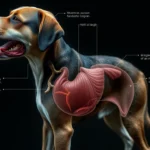
Introduction
Maintaining the health of our canine companions is a vital responsibility for dog owners. Regular health check-ups not only help in early detection of potential health issues but also ensure that our dogs live long, happy lives. Just like humans, dogs require ongoing care and attention to thrive, and pet owners play a crucial role in this regard.
One of the most remarkable aspects of dogs is their acute sense of smell, which is far more advanced than that of humans. This unique ability allows dogs to detect a variety of scents, including those that indicate the presence of diseases such as cancer. Understanding what dogs do when they smell cancer can open new avenues for early detection and treatment, emphasizing the importance of health care practices.
Understanding Dogs’ Sense of Smell
Anatomy of a Dog’s Nose
A dog’s nose is a complex organ that contains up to 300 million olfactory receptors, compared to a human’s mere 5 million. This anatomical feature allows dogs to detect scents at incredibly low concentrations. The structure of a dog’s nose is designed to enhance the ability to capture and analyze smells. The olfactory bulb—responsible for processing odors—is proportionately larger in dogs than in humans, which further amplifies their sense of smell.
How Dogs Process Scents
When a dog sniffs, air enters the nasal passages, where it is filtered and analyzed. The olfactory receptors identify various scent components, while the dog’s brain interprets these signals. This process enables dogs to differentiate between countless smells, including those associated with various diseases. For instance, the presence of certain chemicals or compounds can signal the onset of illness.
The Smell of Disease
When it comes to cancer, specific changes in a person’s body odor can occur due to the metabolic processes associated with tumor growth. Cancer cells produce unique volatile organic compounds (VOCs) that can be detected by a dog’s sensitive nose. Research has shown that dogs can identify various types of cancer, including lung, breast, and colorectal cancers, through scent detection alone.
How Dogs Detect Cancer
The Science Behind Cancer Detection
The science of dogs detecting cancer revolves around the VOCs released by cancerous cells. These compounds can alter a person’s natural scent, which dogs can pick up with their remarkable olfactory capabilities. Studies have demonstrated that trained dogs can accurately identify cancer in biological samples, such as breath or urine, with a high degree of reliability.
Training Dogs for Cancer Detection
Training dogs to detect cancer involves a systematic approach that includes conditioning them to recognize specific scents associated with various cancers. This training often employs positive reinforcement techniques, rewarding dogs for correctly identifying samples that contain cancer markers. Programs dedicated to this cause have shown significant success, highlighting the potential of dogs in early disease detection.
Real-Life Cases
There are numerous anecdotes of dogs detecting cancer in their human companions. For instance, a dog named Maggie alerted her owner to a lump that turned out to be malignant. Similarly, a therapy dog named Oscar consistently identified patients with cancer in a hospital setting, leading to timely interventions. These stories not only illustrate the incredible bond between dogs and humans but also underscore the potential for integrating canine detection into healthcare practices.
Importance of Regular Health Care for Dogs
Routine Vet Check-Ups
Regular veterinary check-ups are paramount for maintaining your dog’s health. It is generally recommended that dogs visit the vet at least once a year, though older dogs or those with pre-existing conditions may require more frequent visits. During these check-ups, veterinarians assess key health indicators, such as weight, coat condition, and dental health, ensuring that any potential issues are addressed promptly.
Vaccinations and Preventive Care
Vaccinations play a crucial role in preventing various diseases in dogs, including parvovirus, rabies, and kennel cough. In addition to vaccinations, other preventive measures such as flea and tick prevention, as well as dental care, are essential for a dog’s overall health. Keeping up with these preventive practices can save both money and heartache in the long run.
Nutrition and Exercise
A well-balanced diet is foundational for a dog’s health. It provides the necessary nutrients that support their immune system, energy levels, and overall well-being. Alongside nutrition, regular exercise is vital for maintaining a healthy weight and preventing obesity. Engaging in daily walks, playtime, and mental stimulation can have a lasting impact on a dog’s health.
Signs of Illness in Dogs
Recognizing Symptoms
As a responsible pet owner, it is crucial to recognize signs that may indicate health issues in your dog. Common symptoms to watch for include changes in appetite, persistent coughing, difficulty breathing, and unusual lethargy. Specific signs that could relate to cancer may include drastic weight loss, unusual lumps, or persistent vomiting. Being vigilant about these symptoms can lead to early diagnosis and treatment.
When to Seek Veterinary Attention
If you notice any concerning symptoms, it is important to consult a veterinarian promptly. Delaying veterinary care can exacerbate health issues, making them harder to treat. Guidelines suggest seeking veterinary attention if your dog exhibits any of the aforementioned symptoms, or if there are sudden changes in behavior, such as increased aggression or withdrawal.
The Future of Dogs in Cancer Detection
Advancements in Research
The integration of dogs into medical diagnostics is an exciting field of research. Emerging studies continue to explore the efficacy of dogs in detecting diseases, including cancer. Researchers are increasingly interested in how these animals can complement existing medical technologies, potentially leading to faster and less invasive diagnostic methods.
Public Awareness and Education
Raising public awareness about the capabilities of dogs in cancer detection is vital. Educating dog owners and the general public about these abilities can lead to better health outcomes for both humans and dogs. Increased awareness can also spur more research and funding into training programs that utilize dogs for early cancer detection.
Practical Tips for Dog Owners
Promoting Your Dog’s Health
To promote your dog’s health, establish a daily routine that includes regular exercise, a balanced diet, and mental stimulation. Activities such as puzzle toys, obedience training, and interactive games can keep your dog engaged and mentally sharp. Socialization with other dogs and people is equally important for behavioral health.
Working with Your Dog’s Senses
Enhancing your dog’s natural abilities can be a fun and rewarding experience. Engage your dog in scent work activities, such as hide-and-seek with treats or scent trails. These activities not only stimulate your dog mentally but also strengthen the bond between you and your furry friend.
Conclusion
In summary, dogs possess an extraordinary ability to detect diseases, including cancer, through their sense of smell. Understanding what dogs do when they smell cancer highlights the importance of regular health care for our canine companions. By being proactive about health check-ups, vaccinations, and nutrition, dog owners can contribute significantly to their pets’ well-being.
The bond between dogs and humans is incredibly special, and recognizing the significance of health care practices can enhance this relationship. As we continue to learn more about the potential roles dogs can play in healthcare, it’s crucial for dog owners to stay informed and vigilant about their pets’ health.









